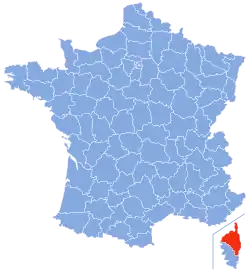Haute-Corse
Haute-Corse (French pronunciation: [ot kɔʁs] ⓘ; Corsican: Corsica suprana [ˈkorsiɡa suˈprana], Cismonte [tʃiˈzmɔntɛ][lower-alpha 1] or Alta Corsica; English: Upper Corsica) is a department of France, consisting of the northern part of the island of Corsica. The corresponding departmental territorial collectivity merged with that of Corse-du-Sud on 1 January 2018, forming the single territorial collectivity of Corsica, with territorial elections coinciding with the dissolution of the separate councils.[3] However, even though its administrative powers were ceded to the new territorial collectivity, it continues to remain an administrative department in its own right. In 2019, it had a population of 181,933.[4]
Haute-Corse
Upper Corsica | |
|---|---|
| Cismonte | |
 Coat of arms  | |
 Location of Haute-Corse in France | |
| Coordinates: 42°28′N 9°12′E | |
| Country | France |
| Region | Corsica |
| Prefecture | Bastia |
| Subprefectures | Calvi Corte |
| Government | |
| • Prefect | François Ravier[1] |
| Area | |
| • Total | 4,666 km2 (1,802 sq mi) |
| Population | |
| • Total | 182,887 |
| • Rank | 92nd |
| • Density | 39/km2 (100/sq mi) |
| Time zone | UTC+1 (CET) |
| • Summer (DST) | UTC+2 (CEST) |
| Department number | 2B |
| Arrondissements | 3 |
| Cantons | 15 |
| Communes | 236 |
| ^1 French Land Register data, which exclude estuaries, and lakes, ponds, and glaciers larger than 1 km2 | |
History

The department was formed on 1 January 1976, when the department of Corsica was divided into Upper Corsica (Haute-Corse) and Southern Corsica (Corse-du-Sud). The department corresponds exactly to the former department of Golo, which existed between 1793 and 1811.
On 6 July 2003, a referendum on increased autonomy was voted down by a very thin majority: 50.98 percent against to 49.02 percent for. This was a major setback for French Minister of the Interior Nicolas Sarkozy, who had hoped to use Corsica as the first step in his decentralization policies.
On 1 January 2018, Haute-Corse's administrative powers were partly ceded to the new territorial collectivity of Corsica.
Geography
The department is surrounded on three sides by the Mediterranean Sea and on the south by the department of Corse-du-Sud. Rivers include the Abatesco, Golo and Tavignano.
Demographics
The people living in the department are called Supranacci. Most people of the department lives on coastal areas throughout highway.
| Year | Pop. | ±% p.a. |
|---|---|---|
| 1968 | 115,702 | — |
| 1975 | 125,284 | +1.14% |
| 1982 | 131,574 | +0.70% |
| 1990 | 131,563 | −0.00% |
| 1999 | 141,603 | +0.82% |
| 2007 | 159,847 | +1.53% |
| 2012 | 170,828 | +1.34% |
| 2017 | 177,689 | +0.79% |
| Source: INSEE[5] | ||
Politics
The current prefect of Haute-Corse is François Ravier, who took office on 3 June 2019.[1]
Current National Assembly representatives
| Constituency | Member[6] | Party | |
|---|---|---|---|
| Haute-Corse's 1st constituency | Michel Castellani | Pè a Corsica | |
| Haute-Corse's 2nd constituency | Jean-Félix Acquaviva | Pè a Corsica | |
Tourism

 Calvi seen from Notre-Dame de la Serra
Calvi seen from Notre-Dame de la Serra Sant'Antonino, one of the most beautiful villages of France
Sant'Antonino, one of the most beautiful villages of France
 Restonica Gorge
Restonica Gorge
See also
Notes
- Also Italian: [tʃiˈzmonte].
References
- Prise de fonction de François Ravier, Préfet de la Haute-Corse, Haute-Corse official website, 4 June 2019.
- "Téléchargement du fichier d'ensemble des populations légales en 2020". The National Institute of Statistics and Economic Studies. 29 December 2022.
- Morgane Rubetti (1 December 2017). "Corse : cinq questions pour comprendre les élections territoriales". Le Figaro. Retrieved 2 December 2017.
- Populations légales 2019: 2B Haute-Corse, INSEE
- Population en historique depuis 1968, INSEE
- Nationale, Assemblée. "Assemblée nationale ~ Les députés, le vote de la loi, le Parlement français". Assemblée nationale.
External links
- (in French) Prefecture website
- (in English) Haute-Corse at Curlie
- (in English) Corsica Isula